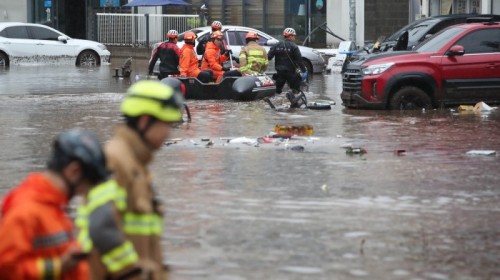 |
| Rescue workers search for missing persons by boat in Nogok-dong, Buk-gu, Daegu, on July 17, after sudden torrential rain caused flooding in the area. / Source: Yonhap News |
On July 18, Friday, heavy rains are forecast to continue across most of South Korea, with particularly intense downpours expected in South Jeolla and South Gyeongsang provinces.
According to weather forecasts, by July 19, the Gwangju, South Jeolla, Busan, Ulsan, and South Gyeongsang regions are expected to receive 100–200 mm of rain, with localized areas seeing more than 300 mm. The Chungcheong provinces, North Jeolla, and Daegu–North Gyeongsang areas could see 50–150 mm, with up to 200 mm in some spots.
Elsewhere, expected rainfall includes 20–80 mm on Jeju Island (over 150 mm in mountainous areas), 10–60 mm in northern Jeju and Ulleungdo–Dokdo, and 10–50 mm on the east coast of Gangwon Province. In the Seoul metropolitan area and mountainous regions of Gangwon, 30–100 mm of rain is expected through the morning of July 20, with parts of southern Gyeonggi and central–southern Gangwon possibly exceeding 150 mm.
The downpours are expected to vary in intensity, with narrow areas receiving extremely heavy rainfall, leading to a wide disparity in precipitation and intermittent lulls.
Strong winds are also expected across most regions, with gusts reaching around 15 meters per second (m/s), and up to 20 m/s in mountainous areas.
As of 5 a.m. Friday, temperatures in major cities were as follows: Seoul 23.2°C, Incheon 22.6°C, Suwon 22.6°C, Chuncheon 21.6°C, Gangneung 21.7°C, Cheongju 22.3°C, Daejeon 21.4°C, Jeonju 22.1°C, Gwangju 21.2°C, Jeju 24.8°C, Daegu 21.7°C, Busan 22.9°C, Ulsan 22.3°C, and Changwon 22.4°C.
The record-breaking rainfall from July 16 to 18 has caused severe human and property damage. At least four people have died due to incidents including submerged vehicles, collapsed retaining walls, and flooded basements in areas such as Seosan and Dangjin in South Chungcheong, and Osan in Gyeonggi Province. Transportation systems—roads, railways, and flights—have been disrupted, while power outages and evacuations have continued.
According to the Central Disaster and Safety Countermeasures Headquarters and the National Fire Agency, four fatalities had been confirmed as of the morning of July 17.
In Seosan, a report of a submerged vehicle was made at 3:59 a.m. on July 17. Firefighters rescued a man in his 60s in cardiac arrest at 6:15 a.m., but he later died in the hospital. At 11:25 a.m., the body of an elderly man in his 80s was found nearby.
In Dangjin, another man in his 80s was found dead in a basement during a drainage operation after being reported missing. A day earlier, on July 16, a man in his 40s was killed when a retaining wall collapsed onto his vehicle in Osan.
The severe weather has caused widespread damage, including power outages, flooded roads and homes, collapsed structures, and overflowing streams that prompted emergency evacuations in some areas. Some schools were forced to suspend operations, and transportation services were disrupted, creating major inconveniences for residents.
At sea, waves are forecast to reach 0.5–2.5 meters on the East Coast and 0.5–2.0 meters on the West and South Coasts. Offshore waves could reach 1.0–3.5 meters in the East Sea, 0.5–2.5 meters in the West Sea, and 1.0–2.5 meters in the South Sea.
Most Read
-
1
-
2
-
3
-
4
-
5
-
6
-
7





















